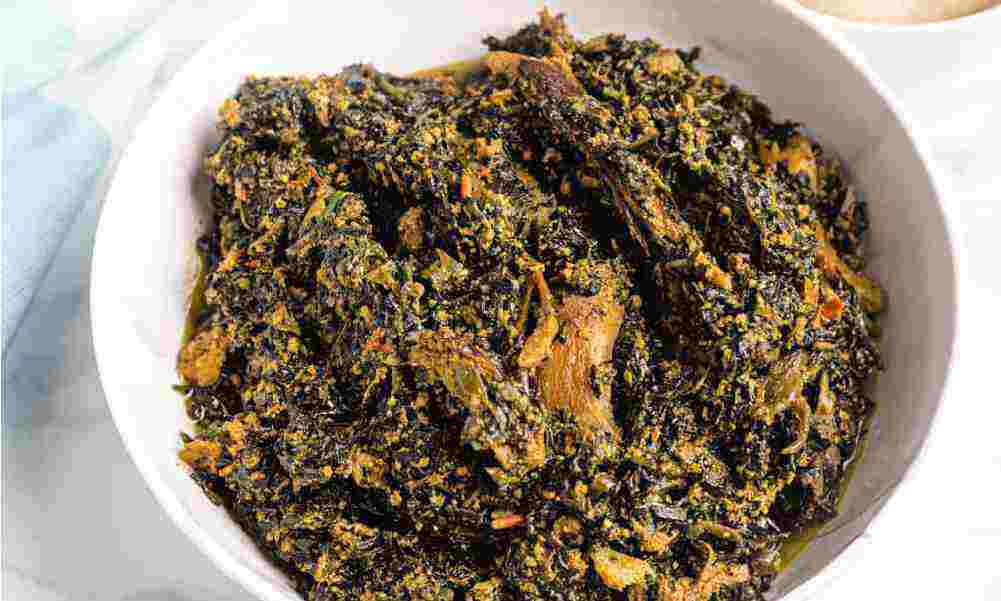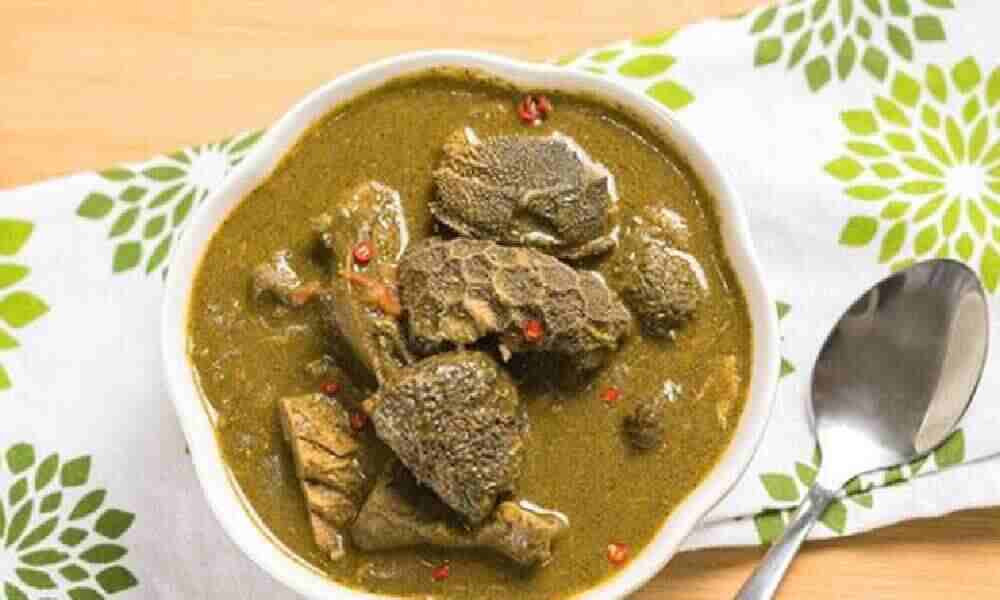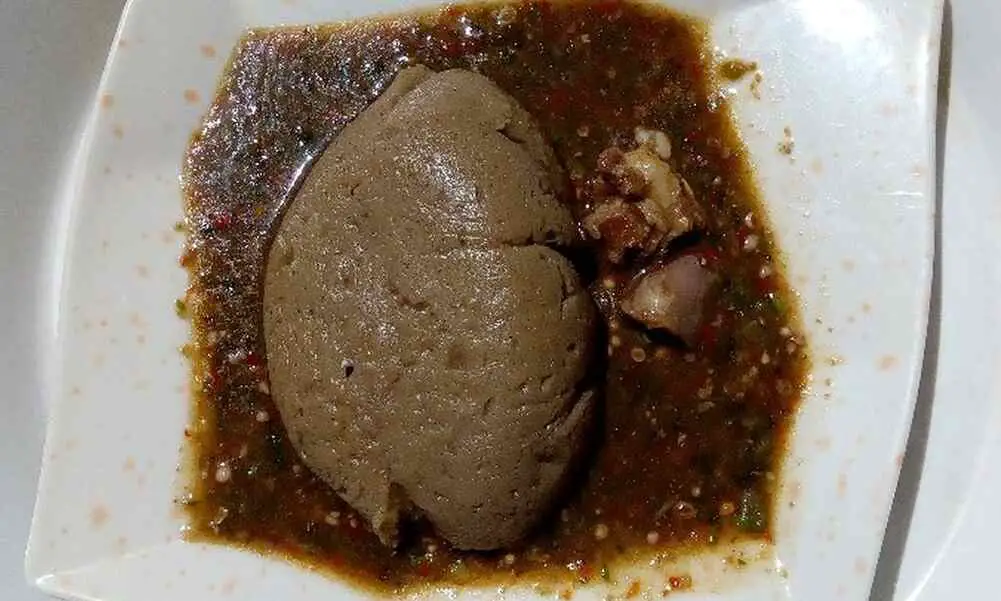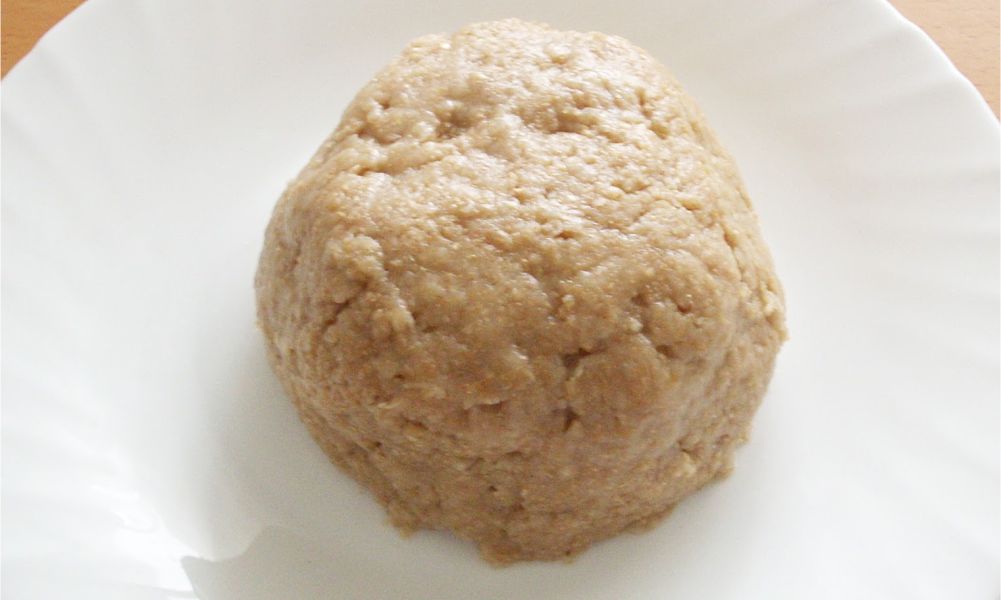
by Fatima Sani | Nov 28, 2021 | Local Delicacies
Bitter leaf soup otherwise known as Miyan shuwaka in Hausa language is a delicacy in northern Nigeria. It is prepared with fresh bitter leaves (shuwaka) and some use the dried leaves, that’s after washing it till the bitterness reduces significantly, then spread under the sun to dry. However, it is not consumed by many. Only a few people like it which largely owes to its bitterness. In this article, I will be guiding you on how to make this delicious northern Nigerian cuisine. Let’s get right into it!
Equipment for Making Bitter Leaf Soup
Cooking pot
Bowl
Kitchen Knife
Scoop
Ingredients for Preparing Bitter Leaf Soup
You will need the following ingredients to prepare Bitter Leaf soup:
Fresh or dried bitter leaves
2 cooking spoons of palm oil
Fresh pepper, onions, and tomatoes (all grinded)
Seasoning cubes – maggi cubes, thyme, curry, etc. (to desired taste)
Salt to taste
2 litres of water (more or less depending on the quantity)
1 cake of locust bean (daddawa)
Boiled or fried meat and/or fish (quantity and size to taste)
Procedure for Making Bitter Leaf Soup
STEP 1: Wash the bitter leaf properly (that’s if you are using fresh bitter leaf) with a small pitch of salt. Squeeze it between your palms till the bitterness has reduced significantly.
STEP 2: Over medium heat, place a pot of oil and pieces of onions in it and allow to fry for 2 minutes.
STEP 3: Add the ground onion, pepper, and tomatoes. Allow to fry for 5 minutes.
STEP 4: Add your clean water (a little bit higher than the quantity you actually need for the soup) to the cooking pot and ground locust beans. Add your meat to it too and allow to boil until the water reduces to the desired quantity.
STEP 5: Add the bitter leaf to the cooking pot with your seasoning cubes, spices, and salt to taste. Allow to cook for 10 minutes.
STEP 6: Stir it well and reduce the heat. Allow to cook for additional 3 minutes.
STEP 7: Turn off the cooker. Ta-Da! Your Miyan Shuwaka is ready!
TIPS:
You can add more water to the soup if you feel it is too thick. In addition, it is advisable to use warm water and not cold water.
Swallows That Best Goes With It
Miyan Shuwaka (Bitter Leaf Soup) is normally taken with Tuwon Semovita or Eba.
How to Serve Bitter Leaf Soup
Aside from Tuwon Semo and Eba, it could also be served with Tuwon Shinkafa, Tuwon Masara, Tuwon Alkama, Tuwon Alabo, and any other swallow of your choice. It tastes best when served hot.
Occasions to Best Serve Bitter Leaf Soup
This delicious northern Nigerian delicacy can be eaten as lunch or dinner. It is served in wedding ceremonies which is mostly common among the Yorubas.
How to Store Bitter Leaf Soup
It is best stored in a refrigerator as it will last for several days. In the absence of a refrigerator nonetheless, it only lasts for a day or two at most, or you will have to be warming it mornings and evenings to last a little bit longer.
Nutritional Value of Bitter Leaf Soup
Miyan Shuwaka (Bitter Leaf Soup) has numerous medicinal values and benefits to human health. The leaf exhibits antibacterial and antifungal properties that make it a good home remedy for several health issues such as diarrhea, high blood pressure, dysentery, and many others.
In addition, Miyan Shuwaka has the ability to improve a crucial female sex hormone that contributes to reproductive development and regulation.
Conclusion
Ensure you wash the leaves properly to reduce the bitterness. This is very important if you do not like bitter tastes else, it will be difficult to consume. More so, as you have seen, it is very easy to prepare without much stress. Now that you know how to prepare Miyan Shuwaka, I hope you will try it at home. Ensure you perfect it first before you choose to make it for occasions.
If you find this article helpful, please leave a comment in the comments section below.
You are always welcome to Northpad Nigeria for more local Northern Nigerian recipes.

by Fatima Sani | Nov 20, 2021 | Local Delicacies
Miyan Kuka also known as Baobab Soup, is a northern Nigerian soup, usually consumed by the Hausas. Other indigenes do consume it too but not as much as the Hausas do. It is made from the leaves of Baobab trees (Adansonia digitata). It is plucked fresh and then dried. When dry, it is then pounded until it is in powdered form. More so, a sieve is used to sieve out unnecessary particles. Don’t worry; you need not go through all that stress as we have it available in our marketplaces and at affordable prices.
Furthermore, I can arguably say that this is the most consumed soup in northern Nigeria and it is mostly consumed by the Hausas. This is because according to research, every 7 out of 10 Hausa households in this part of the country consume Miyan Kuka every day and at any time of the day.
This most consumed northern Nigerian cuisine is easy to prepare and tastes delicious when it’s properly made. This article seeks to teach you how to prepare Miyan Kuka. Let’s get into it.
Equipment for Making Miyan Kuka
Cooking pot
kitchen knife
Greater
Wooden spoon
Whisk
Ingredients Needed for the Preparation of Miyan Kuka
7 tablespoons of Kuka powder.
½ cup of palm oil.
Boiled meat and/or fish (quantity and size to taste) and broth.
Ground or pounded locust beans (daddawa).
Ground onion and pepper. Tomato is optional.
Spices like maggi and salt (to taste).
2 cups of water.
Procedure for Preparing Miyan Kuka
STEP 1: Put a clean pot on low heat and pour in your palm oil.
STEP 2: Slice a little onion and put it into the pot. Then;
STEP 3: Allow to fry for 3 to 5 minutes under low heat until it turns brown.
STEP 4: Add in the grinded pepper, onions, and tomato (optional). Cook for 10 minutes.
STEP 5: Add in the grinded locust beans, the boiled meat and/or fish and its broth, and cups of water. Allow to cook for 15 minutes.
STEP 6: Add in your spices and stir well with a wooden spoon, allow to cook for 5 minutes.
STEP 7: Add the Kuka powder, spreading it little by little as you stir with a whisk (locally called maburgi) to ensure you get the desired mixture and avoid lumps. Then;
STEP 8: Reduce the heat and allow it to simmer for 5 minutes. Ta-da! Your delicious Miyan Kuka is ready to be served.
Swallow That Goes Best With It
Traditionally, Miyan Kuka is mostly dished with Tuwon Masara. In addition, it can also go with Tuwon Shinkafa, Tuwon Alkama, Tuwon Semo, and Tuwon Dawa.
How to Serve Miyan Kuka
Serve Miyan Kuka with a swallow of your choice side by side; that’s how I prefer it. Well, some people prefer it in different dishes, but if you want to feel like an actual Hausa person, eat it from the same plate – the traditional way. Remember to serve hot; the taste is better.
Occasion to Serve
This kind of delicacy isn’t meant for any occasion specifically. It can be consumed as breakfast (dumame, my favourite), or for lunch and dinner. Do not… I repeat, do not serve Miyan Kuka on occasions like weddings. Your wedding will be tagged as the worst ever! It is basically for consumption at home.
How to Store
Its way of storage isn’t different from other local delicacies like Miyan Kubewa, Miyan Karkashi, and the likes. It should be stored in a refrigerator to avoid spoilage. Also, with constant electric power, it can last for a month in the refrigerator. However, in its absence, it only lasts for 3 days. For me, I like to make mine in small quantities to avoid wastage.
Nutritional Value of Miyan Kuka
Miyan Kuka is very rich in Vitamin C together with other essential nutrients like alpha and beta-carotene. This reduces the possibility of cancer development and poor bladder health. It is also of great importance to humans nutritionally as it is rich in medical elements or properties that help in treating common illnesses. More so, it is a great ailment for the treatment of antipyretics, common cold, and diaphoretic.
It becomes more nutritional when you consider the vegetables, spices, fish or meat, etc. in it.
Conclusion
Now that you have learned how to prepare Miyan Kuka, tell me when you will try this at home? Prepare it and make your Hausaman proud.
If you find this article helpful, please leave a comment in the comments section below. Thanks.
You are always welcome to Northpad Nigeria for more local Northern Nigerian delicacies.

by Fatima Sani | Nov 13, 2021 | Local Delicacies
Tuwon Dawa specifically, is the least consumed of all the types of Tuwos that we have (Tuwon Shinkafa, Tuwon Alkama, Tuwon Masara, Tuwon Semo, etc.). It is usually dark brown, kind like Yoruba’s most decorated swallow – Amala. It is easy to prepare, just like Tuwon Masara and the procedure for its preparation is somewhat the same. This article seeks to teach you how to prepare Tuwon Dawa (yadda ake Tuwon Dawa) without much stress.
Permit me to go straight into it!
How to Prepare Tuwon Dawa
Equipment
Cooking pot
Wooding spatula
Bowl
Warmer
Leather
Ingredients for Making Tuwon Dawa
Ingredients needed to prepare this recipe are:
Guinea corn Flour
3 liters of water.
Procedure for Making Tuwon Dawa
STEP 1: Grind the guinea corn into flour and sieve it well. Ensure fine texture
STEP 2: In a clean bowl of cold water, pour a little guinea flour into it. Stir it well until perfectly mixed and in a watery state. (This is known as the talge).
STEP 3: Over medium heat, get a clean pot containing 3 liters of water on the fire and allow it to boil.
STEP 4: Pour the mixture in Step 2 into the boiling water. Stir properly until thick like pap.
STEP 5: Allow boiling for 5 minutes.
STEP 6: Add the guinea corn flour into the pot little by little as you stir. Continue to stir until desired thickness is achieved.
STEP 7: Reduce the heat of your cooker and allow it to steam for 5 minutes.
STEP 8: Mold your Tuwon Dawa into balls, put them in leather, and put them in a warmer.
Soup that Best Goes with Tuwon Dawa
The common soup that is usually taken with it traditionally is Miyan Kuka. In addition, it could also be taken with Miyan Kubewa (Okra soup) – fresh or dried Okro, Miyan Taushe, Miyan Karkashi, Miyan Wake, etc.
How to Serve Tuwon Dawa
It is best served hot.
Occasions to Serve Tuwon Dawa Best
It is best consumed as lunch and dinner. Sometimes, the surplus can be used as breakfast (as dumame). Dumame is the Hausa name for double-fire.
But it’s not advisable to serve during festive periods like Eids. It is also not advisable to serve on wedding ceremonies, naming ceremonies, birthdays, etc.
How to Store Tuwon Dawa
By warming it in the morning and evening, it could last for 2 days. However, if kept in a refrigerator, it could last for more days, although, its tastes could be affected. So, preferably, make just enough for consumption and probably for not more than 2 days.
However, just like Tuwon Semo, Tuwon Dawa is not interesting when warming it the traditional way (i.e. putting the molds in a pot containing water and allowing it to boil). The best way to warm it is by using a microwave.
Health Benefits of Tuwon Dawa
As humans, we need the energy to take care of our daily life struggles. As such, we need this northern Nigerian delicacy as it contains a high amount of carbohydrates.
However, it is not advisable for diabetic patients as it contains a high amount of starch. So diabetics should keep off, please.
Conclusion
As you have seen, Tuwon Dawa is very easy to prepare. It could even be prepared by an amateur cook – like children learning to cook. In addition to its importance, it tastes nice. Nonetheless, one of its setbacks to many is that it is not good-looking at all, I must say.
Personally, I prefer to take it in the evening. Now tell me, when do you intend to make this for yourself or your family?
If you find this article helpful, please leave a comment in the comments section below. Thank you.
You are always welcome to Northpad Nigeria for more local Northern Nigerian delicacies.

by Fatima Sani | Oct 10, 2021 | Local Delicacies
Tuwon Alkama is one of the most favored current trending foods in Nigeria. It is specifically a delicacy prescribed by doctors for diabetic patients. It is consumed mostly by the Hausa people of northern Nigerian. Furthermore, it is also easy to make and tastes delicious. Have you been wondering how to prepare this trending food in Nigeria is been prepared? Stay with me as this article seeks to guide you on the steps to prepare your sumptuous Tuwon Alkama.
Equipment Needed
Pot
Wooden spatula
Ingredients for Making Tuwon Alkama
The ingredients needed to make this delicacy are just 2 cups of wheat flour and 3 liters of water.
Procedure for Making Tuwon Alkama
STEP 1: Wash and dry wheat in the sun and grind to a fine flour and sieve it.
STEP 2: Get a pot of water of 3 liters on fire and allow it to boil. Then;
STEP 3: Add a little wheat flour to a cold bowl of water and stir to mix to a watery state
STEP 4: Add step 3 to the boiling water and stir until it becomes thick like pap (talge)Then;
STEP 5: Allow to cook for 5 minutes. Then;
STEP 6: Add the wheat flour to the content in the pot little by little and stir well until it is smooth and reaches the desired thickness.
STEP 7: Reduce your cooker heat and allow to simmer for 10-15 minutes. Then;
STEP 8: Mold into balls and put in a warmer.
How to Serve Tuwon Alkama
Tuwon Alkama can best be served with soups such as Miyan Kubewa (Okro soup), Miyan Kuka (Baobab soup), Miyan Karkashi, Miyan Gyada, etc.
Occasions to Serve Best
Tuwon Alkama when served with any of the above-mentioned soups can be feasted as dumame (also known informally as double fire) in the morning, or freshly served as lunch and dinner too.
Just so you know, dumame is the food that is consumed as breakfast which is prepared from the remains of unconsumed food from the previous day that is still edible.
How to Store Tuwon Alkama
This delicacy can be stored for a day or 2 as long as it is warmed morning and evening. So, I advise you to make just the quantity you need at the moment. However, if you choose to store it in a refrigerator, it may be okay for a few more days but its taste will greatly be affected.
Nutritional Value of Tuwon Alkama
When served, this delicacy has rich nutritional value, depending on how you choose to serve it. The delicacy itself contains carbohydrates because of the wheat (alkama) in it; this provides you with the energy needed for your day-to-day activities. In addition, a diabetic patient can enjoy it as it is one of the foods most recommended for diabetic patients by medical practitioners.
Conclusion
Now that you have learned how to prepare Tuwon Alkama (Wheat Swallow), when do you intend to have a taste of it by preparing it yourself?
If you find this article helpful, please leave a comment in the comments section below. Thank you.
You are always welcome to Northpad Nigeria for more local northern Nigerian delicacies.




